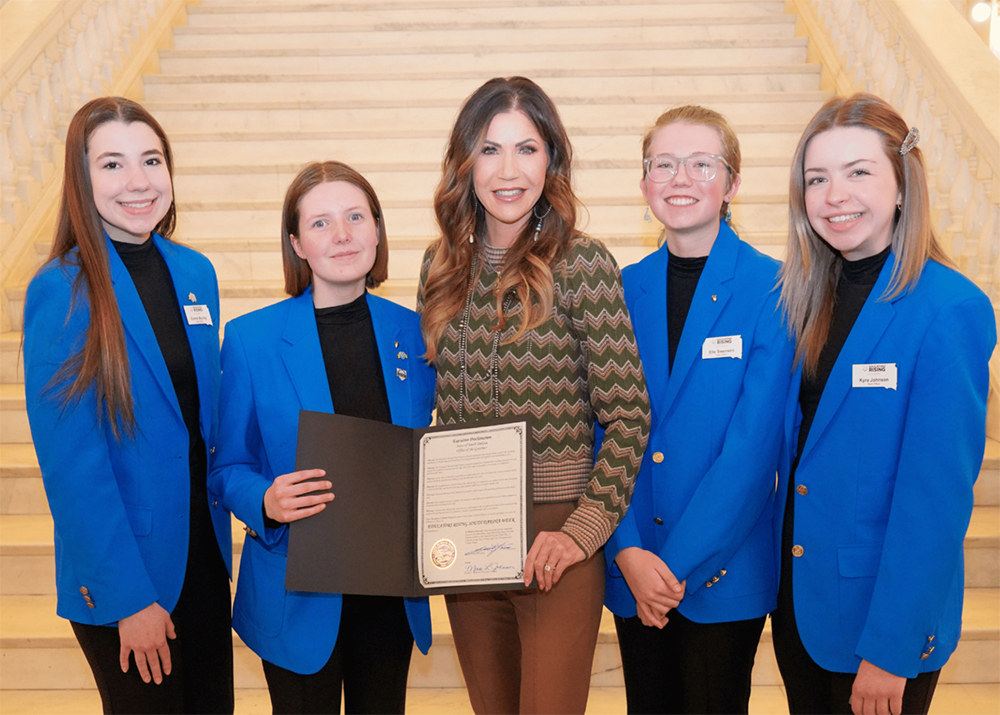South Dakota High School Course Trains Students to Become Child Care Workers
Program helps address industry workforce shortage.

Get stories like this delivered straight to your inbox. Sign up for The 74 Newsletter
There are 12,260 licensed child care slots in Sioux Falls, but 64% of child care centers can’t enroll their licensed capacity because they don’t have enough workers, according to the Sioux Falls Childcare Collaborative. That cuts actual available slots by hundreds — and it’s a familiar situation across the state.
The collaborative presented the results of a six-month study in June, detailing affordability challenges — for parents and caregivers — and potential solutions to address the need.
One of those recommendations was “increase career pathways to the profession,” such as creating a high school dual-credit program or developing internships and job training programs.
Beginning this fall, one of those solutions will kick off in schools across the state: a high school-level Child Development Associate (CDA) course. The course will allow high school students to earn the credential to work toward becoming an early childhood education professional at day cares and preschools while earning high school credits toward graduation.
“We can’t keep talking about how there’s a teacher and early childhood shortage and not do anything about it,” said Summer Schultz, incoming superintendent of the Brookings School District and former Dell Rapids superintendent. “Our preschools and day cares need to keep staffed with quality people. This opens the door for more trained individuals at an earlier date.”
The program allows any student in South Dakota interested in early childhood education to earn a CDA credential through a virtual course. Larger school districts, like Aberdeen and Harrisburg, will have their own in-person courses, said Travis Lape, innovative programs director at Harrisburg and Educators Rising SD state director.
The program was created through a partnership between Educators Rising SD, the state Department of Social Services, Sanford CHILD Services and the federal Department of Education Head Start Collaboration Office.

The course combines required class time with required on-site training at day cares. Students will work 480 hours at a day care before earning their credential. While those students will have to be supervised at all times and won’t be left alone with children, it will be another set of hands to care for children, Lape said.
“Let’s say that the Sioux Falls School District alone had 100 kids in this course. We’d need 100 placements for those kids to earn their 480 hours. That’s 100 new employees,” Lape said. “If Harrisburg has 60, that’s 160 between the two school districts in the Sioux Falls metro. This attacks the early childhood education workforce in that we’ll have 16- to 18-year-olds who are passionate about early childhood education wanting to get their feet wet and work.”
Lape said the online virtual class will allow 30 students to attend in the first year and train at day cares in their community. About 10 spots are already filled, with student locations ranging from Madison to Yankton to Deuel County and Faulkton County. Lape expects more students will sign up throughout the summer.
Harrisburg and Aberdeen school districts will have about 100 students between the two school systems taking in-person classes this school year, Lape estimated.
Currently, day care workers seeking their CDA credential in South Dakota attend an online course run by a third-party agency funded by the state DSS. Sanford CHILD Services operates training in the Sioux Falls metro and Aberdeen areas, and it already had an online course and curriculum in place. It was relatively simple to turn the existing training into high school coursework with the partnership, Lape said.
The program “puts South Dakota well ahead of the curve” in addressing worker shortages in the field, said Deborah Bergeron, deputy director of collaboration and innovation for National Head Start Association. While there are CDA programs in high schools in other states, those are in individual schools rather than being available statewide.
Bergeron hopes to see students fill needed positions at Head Start locations across the state. Head Start is a federally funded program that delivers early learning, health, nutrition and family support services to impoverished children up to age 5. South Dakota has 154 Head Start centers.
Nationally, 20% of Head Start and Early Head Start classrooms were closed between May and September 2022, primarily due to staff vacancies. That meant sending children home, where some parents couldn’t work or had to attempt to enroll them in programs that were too expensive.
“We serve the most vulnerable kids in the country,” Bergeron said. “The impact is more than the kid not attending preschool. Head Start is where they generally get the best nutrition, where they’re connected with well child visits at the doctor, where we catch early learning disabilities that might not get noticed otherwise.”
The program will only address the “increased pathways” recommendation by the Sioux Falls Childcare Collaborative. Other factors, such as low employee salaries, are major factors in the workforce shortage.
The mean hourly wage for child care workers in Sioux Falls in May 2022 was $12.34, about $26,000 a year. The report recommends subsidizing child care by local businesses, the city or state government to help address that issue.
Students in the new CDA course will attend two classes a week for 90 minutes each. Outside of class, students will work in local child care centers to earn their 480 hours of on-the-job supervised experience.
“If a school has to fund a math teacher or an education training teacher, you know where they’ll fund it. It’s the math teacher, even though we know we need an education training teacher for teaching the next generation of teachers,” Lape said. “We wanted to take that barrier away.”
Typically, it would cost $800 for a child care provider to earn the credential, but the program doesn’t charge students. DSS awarded Sanford a contract to provide the instructor and coursework, Lape added.
If students decide not to enter into the workforce directly after high school, the program could count toward credit hours to earn an associate or bachelor’s degree in the field. Lape said it’s a launching point for students who might be interested in other teaching paths outside of early childhood education.
“This training is not going to make you a bad teacher,” Lape said. “If anything, it’ll help you understand the bigger picture — development, safety, health and wellness. It’s a stepping stone.”
South Dakota Searchlight is part of States Newsroom, a network of news bureaus supported by grants and a coalition of donors as a 501c(3) public charity. South Dakota Searchlight maintains editorial independence. Contact Editor Seth Tupper for questions: [email protected]. Follow South Dakota Searchlight on Facebook and Twitter.
Get stories like these delivered straight to your inbox. Sign up for The 74 Newsletter

;)